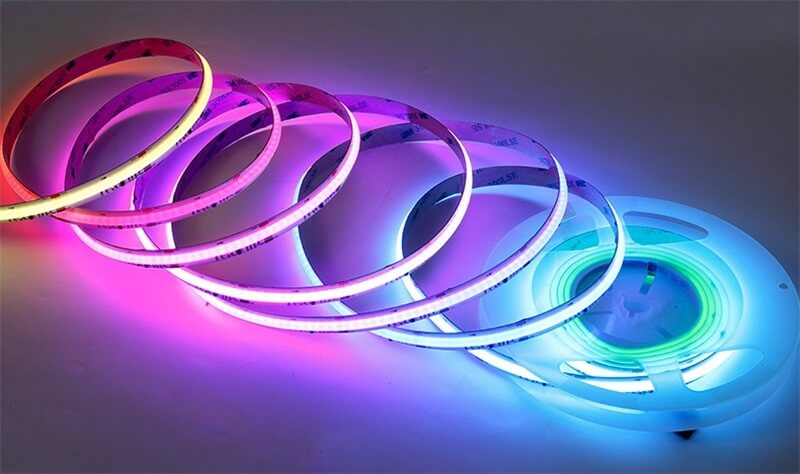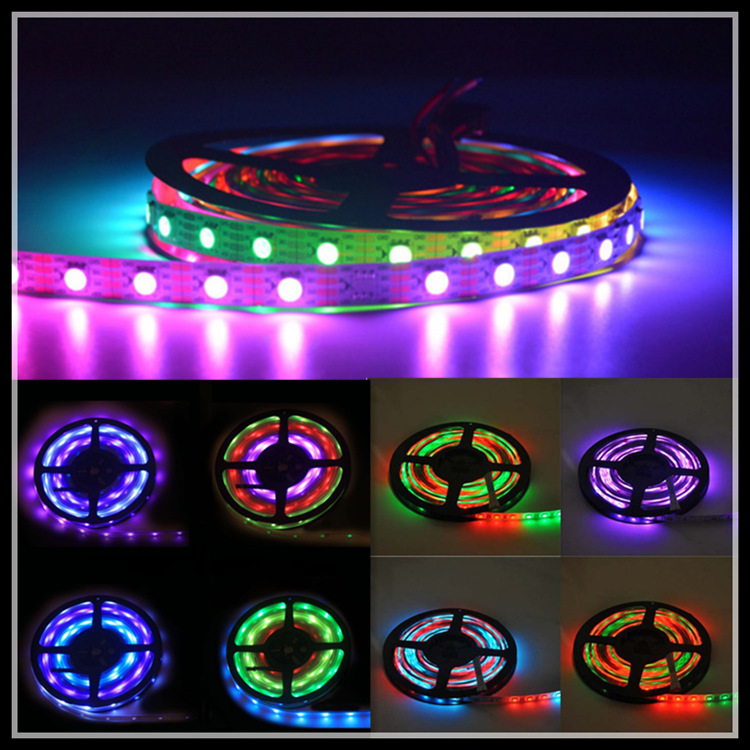What are the advantages and disadvantages of COB magic light strip and LED magic light strip?
With the continuous advancement of lighting technology, strip light products have become increasingly popular in both decorative and functional lighting applications. COB RGB LED strip lights and traditional RGB LED strip lights are two mainstream products on the market, each with its own technical characteristics and application scenarios. This report provides a detailed comparative analysis of these two types of strip lights to help consumers and industry professionals make more informed decisions when purchasing.
I. Introduction to COB RGB LED Strip Lights
COB (Chip On Board) RGB LED strip lights are lighting products that encapsulate multiple LED chips directly onto the circuit board. Compared to traditional SMD (Surface Mounted Device) LED strip lights, COB strip lights have a higher integration level, allowing for tighter LED spacing, resulting in more uniform light output and smaller light-emitting points.

II. Introduction to Traditional RGB LED Strip Lights
Traditional RGB LED strip lights typically use SMD technology, where each LED is individually encapsulated and soldered onto the strip. These strip lights are widely favored for their flexible design, rich color options, and easy installation. RGB LED strip lights can achieve various lighting effects through controllers, including color changes, gradients, flashing, and more.

III. Advantages of COB RGB LED Strip Lights
-
Uniform Light Output: COB strip lights, due to their dense packaging technology, offer a more continuous and uniform light-emitting surface. Compared to traditional LED strip lights, they effectively eliminate light spots and provide a soft linear light effect, making them ideal for applications requiring seamless lighting.
-
Wider Beam Angle: COB strip lights typically offer a beam angle of 180°, compared to 120° for traditional LED strip lights. This wider beam angle makes them more suitable for large-area lighting.
-
Higher Light Efficiency and Energy Savings: COB strip lights provide higher light efficiency, meaning they can deliver more brightness at the same power level. Additionally, COB strip lights consume less energy, offering better energy-saving benefits.
-
Strong Flexibility and Operability: COB strip lights are highly flexible and can be bent and twisted more freely, making them suitable for various complex installation requirements.
IV. Disadvantages of COB RGB LED Strip Lights
-
Higher Cost: The manufacturing process of COB strip lights is more complex, resulting in higher costs. Projects with limited budgets may lean towards traditional LED strip lights.
-
Limited Color Performance: Although COB strip lights can achieve RGB effects, they may be slightly less versatile in color performance and dynamic variations compared to traditional LED strip lights.
V. Advantages of Traditional RGB LED Strip Lights
-
Rich and Diverse Colors: Traditional RGB LED strip lights offer greater flexibility in color performance. Through controllers, users can achieve various lighting effects, such as RGB color changes, gradients, and chasing effects, making them ideal for scenes requiring complex lighting effects.
-
More Competitive Pricing: The manufacturing cost of traditional RGB LED strip lights is relatively lower, giving them a pricing advantage. For large-scale commercial lighting projects, the cost-effectiveness is more apparent.
-
Mature Market: Traditional RGB LED strip light technology is mature, with a wide variety of products available, offering consumers more choices. Additionally, the compatibility of accessories and control systems is strong, making installation and maintenance easier.
VI. Disadvantages of Traditional RGB LED Strip Lights
-
Uneven Light Output: Due to the spacing between LED chips, traditional RGB LED strip lights may exhibit light spots and uneven light output when viewed up close, which may not be ideal for some high-demand lighting designs.
-
Higher Heat Generation: The heat generated between LED chips is higher, and additional cooling measures may be required during long-term operation to prevent the strip light from overheating and affecting its lifespan.
VII. Conclusion
Both COB RGB LED strip lights and traditional RGB LED strip lights have their advantages and disadvantages. COB RGB LED strip lights excel in uniform light output, beam angle, and energy efficiency, making them suitable for scenarios requiring high-quality lighting effects. However, their higher cost and relatively limited color performance may be constraints for some projects.
On the other hand, traditional RGB LED strip lights, with their rich color options, competitive pricing, and mature market, are suitable for a wide range of commercial and residential lighting applications, although they may fall short in terms of light uniformity and heat management.
The choice between the two types of strip lights should be based on the specific project requirements and budget. For users seeking high-quality lighting and energy efficiency, COB RGB LED strip lights are a better option, while traditional RGB LED strip lights are more suitable for those needing versatile lighting effects and working with a limited budget.




